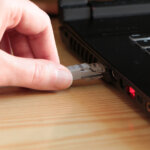Common problems with connecting to a wifi network

The promise of the modern age of ubiquitous wifi connection is that it’s easy. You should, more or less anywhere you go, be able to connect to wifi, so when you get a message saying “unable to connect to network,” it feels more than frustrating, and more than irritating. It feels like a betrayal of that promise. Dude, seriously, connect me to the network!
READ NEXT

Wired or wifi computer connection?
Relax. Breathe. There could actually be any number of things behind your “unable to connect to network” message. Before you throw your laptop across the room for the oath-breaking slice of lies it is, let’s take a look at the most common issues behind an inability to connect to the network.
Unable to connect to network.
This is the big one, the most enraging denial of everything that should be yours by right. Annoyingly, it’s also one of the more complex potential issues to deal with, because it gives you very little by way of explanation of why you can’t connect to the network, and there might actually be any number of things stopping you from doing so. The three most common of those issues are: a) an issue with your device, b) an issue with the router, and c) an authentication issue.
Device issues.
If your device has been happily connecting to wifi networks before you have your problem, you may not believe this, but the 21st century cliché is true – the best thing to do in the first instance is to turn it off and on again. No, we can’t believe we wrote that, either – but it’s true. It may be that your device is due an update, and you might trip one by the restart, which solves your issue.
If you restart your device and it still refuses to speak to the router, check your device’s wifi settings, make sure the network you’re trying to connect to is showing as available, and check if you can use a hotspot network to get around the issue.
If you still can’t connect to the network, try one more thing – run an offline security check with whatever program you use to check for cyberthreats. It’s unlikely, but something might have gotten into your system that stops you connecting to the network.
If you do all that, and you still can’t connect, don’t fling your laptop across the room like a silicon frisbee just yet. There may be other explanations for your inability to connect.
Router issues.
If you’re at home or work, you should be able to see your router – the concierge that stands between your device and the wonders of the internet. In work, if you’re noticing you can’t connect, it’s possible other people are having the same issue. Stick a hand in the air, yell out for confirmation, and if your plea raises a chorus of groans from fellow sufferers, congratulations – you have yourself a router connectivity issue, rather than a device connectivity issue.
At home, go take a look at your router. It should normally be glowing with the smug satisfaction of some lights in one of the reassuring colors – blue and green are particularly popular. If you see anything red or orange, or if its lights are blinking, rather than constant, then your router is having, at the very least, a hungover episode.
Turn it off and keep it off for a couple of minutes, then restart is and see if that makes it happier with its lot in life, and prepared to connect you to the network again.
If not, it may still not be a router issue – use your smartphone’s data to check the website of your internet service provider to check for outages or maintenance work in your area. If there is none, or none is showing, while you have your smartphone to hand, it may be time to call your provider and see about getting a new router – or to see whether they have any device-specific information about how to resuscitate your equipment.
If you’re in a public space, mention your inability to connect to a member of staff. Unless the issue has just occurred, you’re unlikely to be the first person to have mentioned it, and they’ll be able to tell you whether there’s an issue with their router. If there is, and it looks like going on for some time, your options are fairly limited – you could use your smartphone as a hotspot to get around the problem, or you could go somewhere else and use their wifi instead while the problem is sorted out.
Authentication issues.
Authentication issues, in some ways, are the most straightforward of network connection issues, because they will usually at least tell you they’re authentication issues. Double-check your connection details, including the password you’re using, and try again.
If that gives you no joy, the tried and tested remedies are your friends. Turn your device off and on again. And if that still doesn’t work, check your wifi settings to make sure your device is configured to allow it to be authenticated. If it is, and you’re still having authentication issues, try an alternative route, like using your smartphone as a hotspot – or, again, move to another location and try getting on the network using their wifi.
Sloooooow connection.
Almost as frustrating as no connection at all is connection that’s so slow it feels like you imagine (or remember) the Nineties were. You can test your speed online (ironically enough), to see whether there are problems with the server you’re trying to connect to, and if there are, perhaps perversely, changing to a server that’s geographically further away from you, but with fewer reported problems, might significantly boost your speed and let you get on with your day.
If you’re on a network that’s running a heavy traffic burden at the time, that can be particularly effective – and can also, assuming no router issues, help others, by taking you off the same server pathway they’re trying to use.
It’s also worth checking your router for any faulty wires, as that can explain simply what might otherwise look like an inexplicable slowness.
Connection drops.
If you can connect to the network fine, but then out of nowhere, your connection drops when you click a link or navigate to a page, there could be one or two issues with your router journey. Use a ping checker to see how fast your connection speed is (it might be suffering, which could cause pages to suddenly drop). If that all seems fine, you might want to try changing channels on your router, as that can give you a smoother ride to the content you need.
Whatever is causing your “unable to connect to network” issues, in most cases there will be ways around it. Don’t panic – just try our home remedies before you pay out for new equipment.









